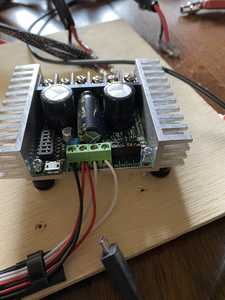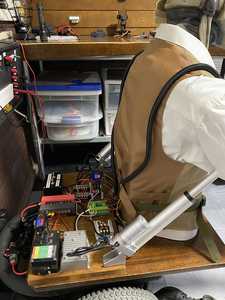Hello,
My robot is heavy, with relatively powerful motors (200+ pounds and 24V/60A batteries). It is a work in progress. While I am concerned about all the boards and components, I am having trouble protecting the motor controller from absorbing jarring and vibrations. The controller is a Sabertooth 2x32.
It recently went bad and caused the robot to run-amuck. Not fun and honestly scared me a bit. Dimension Engineering, has repaired it for me. The tech said the PCB had severe damage as if it had been dropped more than once. It has not. So it is due to the rough ride I suppose. The company has been great by the way.
I had it mounted in the robot base, screwed on a piece of wood using rubber grommets to reduce vibration, but not attached to the frame. I have included a few pictures to help visualize.
Are you aware of any better ways to dampen the jarring of the PCB? I thought of mounting on a silicon pad. I've researched this issue thoroughly. Read many technical articles and they are either too basic or far too high-end for me (meaning very expensive options used in aircraft, for example).
I'm stuck. Thanks for your ideas.
Don
What is the source of the jarring and vibrations?
Maybe four springs with a tension best set to absorb whatever the main vibration frequency is?
Maybe put the electronics in a box and suspend it with eight springs?
Yes wheelchair motors can be very powerful and thus dangerous as a robot base.
@robotbuilder Thanks for the response. I assume the jarring is the robot stopping and stopping quickly, or just generally while it is mobile. I need to tone down the torque overall and speed, I can do this partly with the software on the sabertooth. I drive it with RC, but soon I am moving to a more autonomous method for some routines. I am holding off on that until I feel I have this issue worked out.
I've thought of some of your ideas, but the idea of putting it in an enclosure and suspending it with springs is intriguing. That might damper both vibrations and the jarring. Not something I could find on eBay (ha), but another fun contraption to fabricate, I suppose.
Thanks again,
Don
My first robot controller used relays to control the motors no speed control. I called it Jerky the Robot 🙂 Even so there was no damage to the circuit board which made me wonder about the source of vibration in your robot base.
Later I used a mosfet Hbridge so I could control the speed with PWM and thus could slow down the speed gradually or increase the speed gradually. You need a slow start, slow stop function which can be implemented as software or hardware.
Do you have bumpers on the robot yet? They can be compliant to prevent a sudden stop.
My now defunct robot was so powerful it could push a couch around and if it contacted a wall it would spin its wheels releasing smoke!! Very dangerous for pets and children. I had intended to use it to mow lawns and carry heavy loads as well as mop the tiles and vacuum the carpets. One reason it was so strong was because I replaced the pneumatic wheels with smaller solid wheels resulting in a slower top speed but with stronger torque on the wheels.
@robotbuilder Sounds like you get my issue. No bumpers, but that would probably be smart. I should get the repaired motor controller soon and I'll try to reduce power. Not sure how to do that via hardware, other than reducing voltage.
And yes, when SAM hits a wall, the walls know it. The time he ran amuck, it was in my workshop and I didn't have it up and off the ground. My bad.
Sounds like your old robot was a beast. Power sounded better when it was a base only, but now that I have many electronic components on it, that is just too much stress on the electronics (and me). I have a new respect for battlebot builders.



